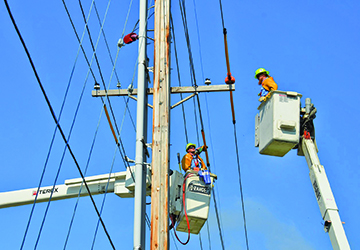


Morgan Sonsthagen

On Havana Street
Expect Xcel Energy’s Summer Bills To Soar
Families Struggle To Pay Bills As Electric Prices Rise; Three-Rate Surge To Jolt Rates $16.49 A Month By Year’s End
by Glen Richardson

Costs Up In The Air: Volatility of global energy market is making it harder for homeowners to keep costs down. A utility helicopter is used to string conductor on a Colorado project.
Are you staring at your electric bill and starting to swelter?
You’re spot-on: The average electric bill from Xcel Energy went up $5.24 a month beginning April 1, a 6.4% increase. Rates for the average small commercial customer went up 6.2%, or about $6.62.
Xcel Energy – Colorado’s largest utility with more than three million electricity and natural gas customers — has also filed an overall natural gas rate increase, seeking a $8.14 price hike beginning November 1. More: Xcel is also asking for a temporary rate increase to recoup $550 million in extra electric and natural gas costs due to a 2021 winter storm. Bottom line: The three-rate increase will jump your energy bill by $16.49 a month by year’s end.
Summer Costs Cook

Coal Closure: Closure of Xcel Energy’s Pueblo coal plant is major factor in rising rates. Utility plans to shutter the Comanche 3 Plant by 2031, ending coal-fired electricity in the state.
This month marks the official beginning of summer as the sun’s rays strike Earth at a more direct angle. Summer solstice begins here at 2:13 a.m. on June 21. Use of electricity will soar in the weeks following. As usage jumps due to summer’s heat, utilities add more expensive generation sources to meet the increasing demand.
Weather is the biggest factor for fluctuation in utility bills. On average 50-60% of summer bills are made up of cooling costs. If your HVAC system runs on electricity, then you’ll see higher totals on your electric bill, especially if you place a higher demand on your HVAC system.
Given the surge in Xcel Energy’s rates already, energy bills this summer are increasingly likely to burn a hole in your wallet. That includes energy produced by solar and wind sources.
“Volatility of the global energy market is making it harder for homeowners to keep control of how much they pay for energy,” states Denise Stepto, communications officer for nonprofit Energy Outreach Colorado. The nonprofit helps those facing “utility shutoff” with programs to halt the crisis and assist them to get back on their feet.
Time Of Use Rates
Cutting down on home energy costs is no longer simply just switching off the lights or insulating the attic. Thus, since March, Xcel Energy has offered “Time of Use Rates” that base prices for electricity on when customers use energy. Prices are higher when customers use more energy and lower when they use less.
The system is divided into three rates: Off-Peak hours — before 1 p.m. and after 7 p.m. each day — the price is just 9.9-cents per kilowatt hour. Mid-Peak hours —between 1 and 3 p.m. — costs are 18.9-cents in the summer and 13.6-cents in the winter. On-Peak hours — between 3 and 7 p.m. — costs are 27.9-cents in the summer and 17.3-cents in the winter.
Weekends and holidays count as Off-Peak times. Summer rates run from June through September; winter rates from October to May. “Summer rates are higher because of the large amount of energy it takes to run air conditioners,” explains Xcel Energy regional VP Hollie Velasquez.
Controlling Bills

Beat The Heat: Keep your thermostat just cool enough to be comfortable, and then bump it up a degree. Each degree above 75ºF saves 10-15% in amount of energy used.
Here are tips from energy experts to help you beat the heat and save money: Get an air conditioner checkup or replacement. Cleaning a clogged AC unit filter alone can save 5-15% in energy cost. Keep your thermostat just cool enough to be comfortable, and then bump it up a degree. Each degree above 75ºF saves 10-15% in amount of energy used.
When home, close doors and AC vents in rooms that are not in use. When it cools off at night, turning off your cooling system and opening the windows lets cool air in plus hot air out. Keeping blinds drawn and windows closed helps keep heat from warming your interior. Also, fans use 1/60th the energy of an air conditioner. More: Ceiling fans can cut back the need for air conditioning, saving up to 40% on electricity.
Xcel Energy also urges users to follow these behavioral changes to contain costs: Run dishwashers at night plus wash and dry clothing during the weekend. Also bake major meals in ovens on weekends, then reheat the food.
Activists Aim At Profits

High Wire Rates: Xcel Energy, Colorado’s largest utility, is jolting homeowners with a sky-high three-rate increase that will jump residential electric bills $16.49 per month by year’s end.
As residential energy rates keep going up, Xcel Energy’s profits in Colorado are in the crosshairs of advocates for senior citizens and taxpayers. AARP says the rate hikes hammer residents who can least afford higher energy bills.
AARP asserts the utility is being allowed to add up to 1-1/2% to a clean energy “revenue rider” on the annual electric bill of monopoly members, including surcharges and franchise fees. The organization also says Xcel can add up to 1/2% of their revenue requirement to develop electric vehicle charging stations. Plus, the utility can add the cost of providing those facilities to their base rates.
Moreover, they argue the utility is entitled to a higher rate of return from electric appliances, furnaces, and hot water heaters. Plus, they also get an accelerated depreciation and are

Cool Summertime Idea: Get an air conditioner checkup or replacement. Denver’s Cooler Company is one of many providing air conditioning system service and repair.
able to retain part of the net economic value.
Profit Sharing?
What’s more, the Independence Institute is proposing an initiative that would require investor-owned utilities to share their annual profits by returning to taxpayers at least 5% of the company’s sales in the state.
Institute president Jon Caldara, head of the conservative think tank says, “Colorado’s system of regulating utilities is broken.” He wants to fix it by creating a proposal to make companies share some of their profits with customers.
His proposal would apply to all utilities that are regulated in exchange for being allowed to recover their costs and receiving an okay for a return on their investments. He makes it clear, nevertheless, that Xcel Energy is the target.
